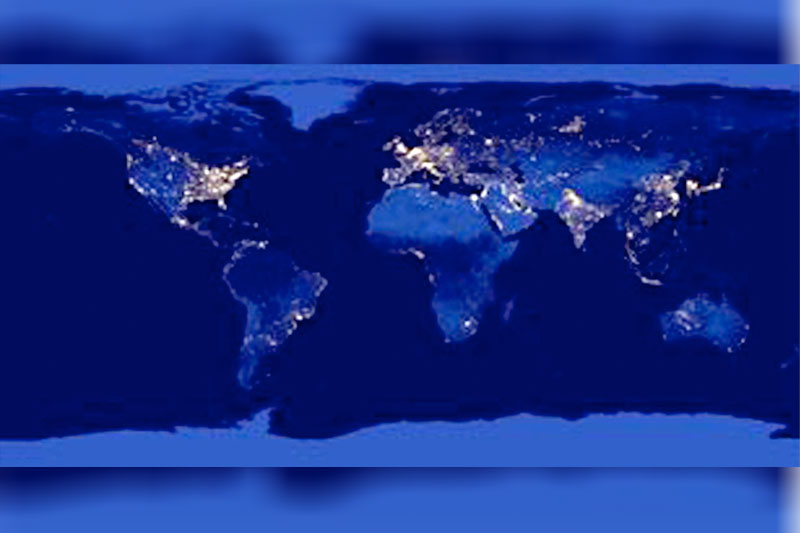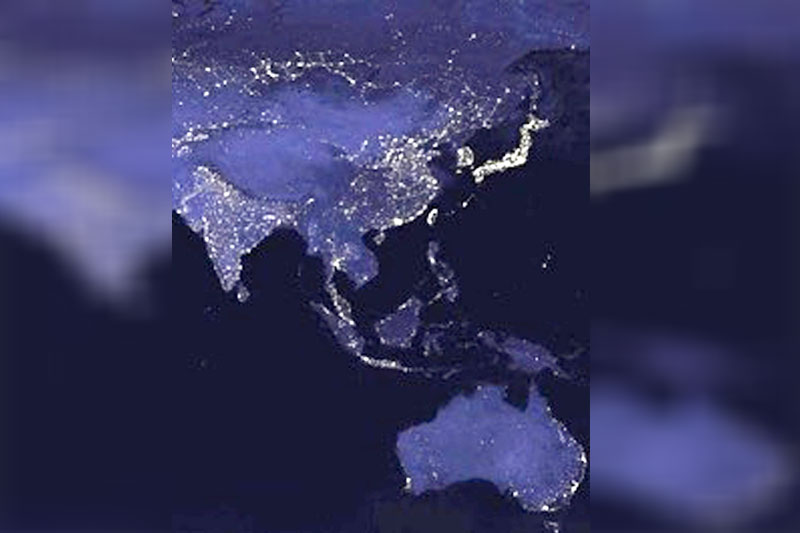Night-views of Earth from space and economic development

We are living in the space age. For decades now, man has been searching for and exploring new worlds outside our frontier.
Yet, from space, our earth is also a subject for observation. Photographs of our home planet (taken and assembled by NASA, the US space agency) enable us to observe ourselves even more closely!
Day- and night-views of earth. Day-views of our planet yield photographic details that are very useful. They contribute toward explaining changes in our landscapes and environment, as well provide climatic and weather information.
Night views provide more compressed information, yielding only light or darkness. It matters, however, what time in each time zone the pictures are shot. Early evening or late night pictures of the same place could make a lot of difference. Urban centers are awake in the early hours of night, but slowly turn down lights as night deepens.
The night-view of our world. I pick a picture of the world, patched up together from various night shots by satellite that zeroes in on areas of earth as it revolves around the sun. The picture is publicly accessible in the internet.
Photo 1 is a flat view of earth, which of course is unrealistic. Planet earth is a sphere, like a ball. All the pictures appear in a panoramic spread, as in a flat map of the globe we see in books. The picture is highly distorted; it shows the northern countries to be bigger in area than they really are.

The highly developed areas of the world are urban centers or cities. Their lights are intense, like those of brilliant stars in the heavens. We see these along the northern hemisphere from Northern America across the Atlantic Ocean to Western Europe and then toward Russia, the vast Asian heartland until the edge of the continent along East Asia on the Pacific Ocean.
South America appears very faint compared to the lights of North America, which are produced by urban centers of the United States. Africa can be seen only because the outlines of that continent are drawn as in a map. Otherwise, it is still a large, dark continent at night.
As countries experience development, they consume more energy. Energy provides power not only to the lights that shine at night. Compared to poorer or less developed countries, highly developed countries use more energy to run factories, drive transport, and facilitate commerce among men and countries. All economic activity can be summarized by the intensity of production, consumption and commerce. And all such economic activities are driven by energy.
In Photo 1, the areas of East Asia appear well-lighted in the large map of the world. Much more detail is presented by a more focused regional night-time map of the area, which is Photo 2 and discussed next.
Details on East Asia. Japan has the brightest lights at night in East Asia. It is also the most economically developed country. South Korea is that rectangular box-like figure facing southern Japan across a narrow sea. The swath of lights of South Korea’s northern end is where North Korea begins. That country, however, cannot be seen as it is essentially dark, until it meets the points of light in China.
China, on the mainland, is lighted by a web of lights along its central and eastern parts on the Pacific Coast. Hong Kong can be detected as the big burst of light on the southern shore lines. Taiwan is that thick ribbon of light across China’s eastern shores.

The major ASEAN countries on the continental mainland appear brightest where Thailand is located. A strip of white light starts from Bangkok (central Thailand) and leads along the peninsula of Malaysia and ends in Singapore where it appears brighter.
The Philippines and Indonesia – two archipelagic countries – can be traced by the lights they form on their main islands. Indonesia’s Java is much better lighted than any of their islands.
To be continued: Philippine photos from space at night-time; India’s lights.
For archives of previous Crossroads essays, go to: https://www.philstar.com/authors/1336383/gerardo-p-sicat. Visit this site for more information, feedback and commentary: http://econ.upd.edu.ph/gpsicat/
- Latest
- Trending



























